Physical and dynamical properties of microplastic particles and their transport in the basin with horizontal and vertical salinity gradient in the Baltic Sea, June 30 – July 10, 20
The main goals of the expedition are (1) to collect microplastics samples on the beach, (2) to collect the water samples at sea surface layer, (3) to gather the bottom sediment samples in Baltic Sea. The tasks include (1) the primary classification of the microplastics types collected on the beach and at sea surface layer, (2) assessment of the main sources and concentration of microplastics in upper 2 cm layer of the beach (shoreline, wrackline, middle zone of the beach, at the bottom of the foredune), (4) evaluation of the microplastic particles distribution in sea water.

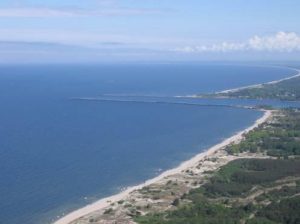
The study area: Baltic sea coastline in the vicinity of Kosa settlement; Baltic sea beach and Baltic Channel moles (from book of Shalaginova et al, 2009).
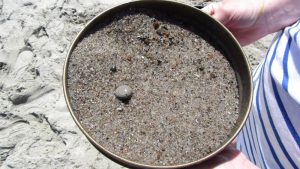
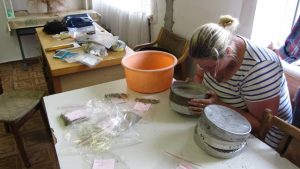
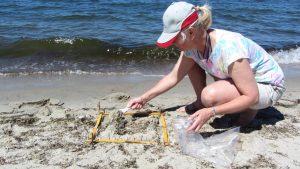
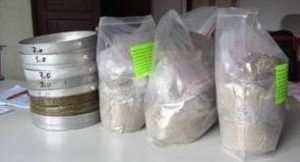
The collection of microplactics on the beach and in the sea (70 m isobaths; 20 km away from moles) and its cameral treatment.
Field expedition in the vicinity of Baltic Spit Village (beach area), May 4-6, 2016
The main task of expedition includes the collection of the sand, pebble and granules for laboratory experiments and sand samples in the middle area of the wrack-line from the beach surface to the sea level.

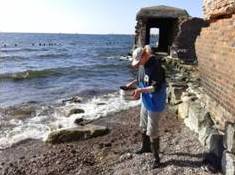
I. Chubarenko, A Grave, E. Esiukova, A. Bagaiev & M Bagaieva are collecting a material of different fractions on the beach, May 4, 2016. 40 kg of sand (size range of 0.5 – 1 mm), 40 kg of pebble (size range of 1-2 cm), and 500 g of granules (size range of 3.5-4.0 mm) were gathered. Photography by I. Chubarenko & E. Esiukova.
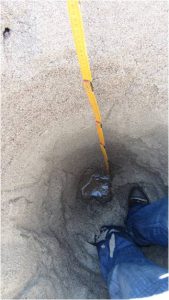
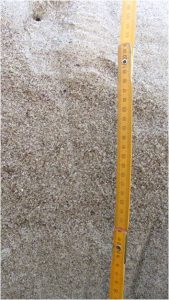
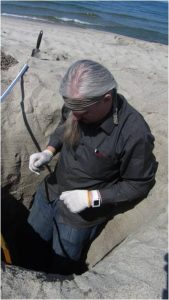
The collection of 15 samples from the sand surface to depth of 143 cm performed every 10 cm on May 5, 2016. The visual examination of digging pit on the beach showed that there are no any debris and pebble. The sand is clean, with different ranges of sand particles. Photos by I. Chubarenko & E. Esiukova.
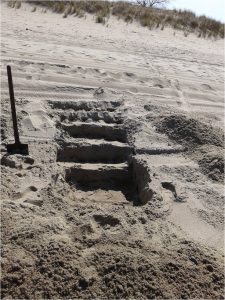
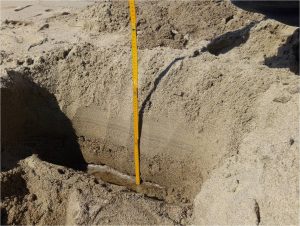
The collection of samples in the ladder-shaped pit on May 5, 2016 performed by I. Chubarenko, A. Bagaiev & M Bagaieva. The bands are 4 cm – sand, 12 cm – coarse sand, 16 cm – fine sand, 22 cm – sand with 2 grey bands, 26 cm – the end of wet sand. Photos by I. Chubarenko & E. Esiukova.
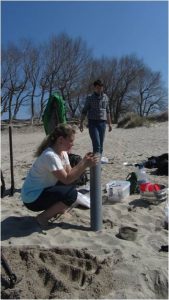
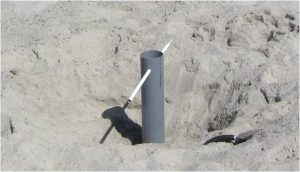
The kerns collection on May 5, 2016 by A. Bagaiev & M. Bagaieva. Photos by E. Esiukova.
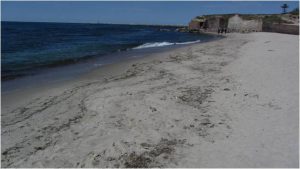

The beach in the vicinity of Shkol’naya Str. and demolition of fortress, May 5, 2016. The excessive amount of macro- and mesoplastic were indicated along the wracklines. There is significant amount of amber, macro-, and mesoplastic on the coastline near the fortress. Photos by E. Esiukova.
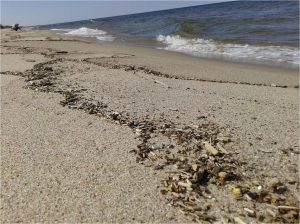
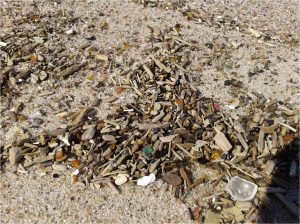
The beach in the vicinity of former airport runway, May 6, 2016. The linear piles of marine debris along the wrackline and sand step were indicated but not over entire beach. Macroplastic coming originally from the sea is scattered rarely but over entire beach apart from the wrackline. On the current wrackline the significant amount of tiny amber crumbs, sea shells, sticks, and microplastic particles were observed. Photos by I. Chubarenko.
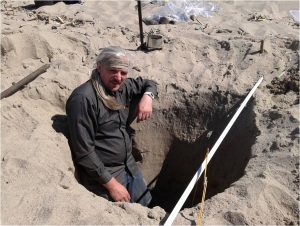
Leading engineer A. Grave is performing the measurement of digging pit depth, where sand samples were collected from 14 levels. Sandy body of the beach consisted of several bands of different colours and grain size; six thin dark sand bands were indicated at 55-73 cm depths, three thin dark sand bands were observed from 72 to 106 cm depth. At 60 cm depth from the surface, the coarse black sand was observed; at 98.5 cm (lower than 11-th sampling level) the sand is brighter and finer. Below 12 sampling level, the pebble in the sand was indicated; soggy. The water level was met at 134 cm depth from the beach surface. At 75 cm depth, the polished wooden stick was found; at 50 cm depth the sea shells were observed. Otherwise, no objects were visually detected throughout sandy beach body. The samples were transported to laboratory for further treatment. Photo by I. Chubarenko.
Field expedition on Zelenogradsk beach, May 27, 2016
The main goal includes the collection (layer by layer) of the sand samples in the middle area of wrackline from the beach surface down to the sea level.
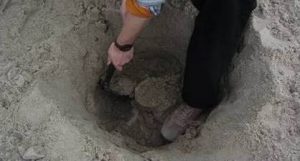
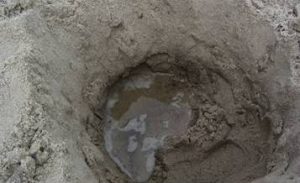
The samples collection by A. Bagaiev & M. Bagaieva from the surface to 54 cm depth. The sand digging pit consists of the following bands: upper 5 cm – dry sand; approximately 20 cm wet sand interleaved with black and unnoticeable bands; below 18-20 cm depth the commencement of wet pebble band (5-7 cm); below – wet, sticky, soaked in water, and medium sand, with the thickness of 17-20 cm, the lower 5 cm – sea water, coarse sand and granules. Photos by E. Esiukova.

The collection of microplastics samples at 4 locations in upper 10 cm sand on the beach performed by A. Bagaiev & M. Bagaieva. Photos by E. Esiukova.
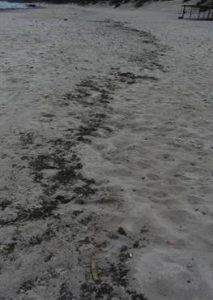
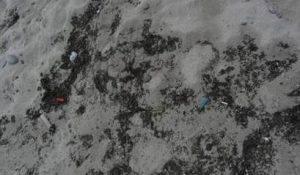
The collection of samples on the wrackline (at the middle of the beach where the excessive concentration of debris washed ashore is observed). The higher concentration of macro- and mesoplastic (and other debris), large pieces of paraffin along the wrackline. Photos by E. Esiukova.
